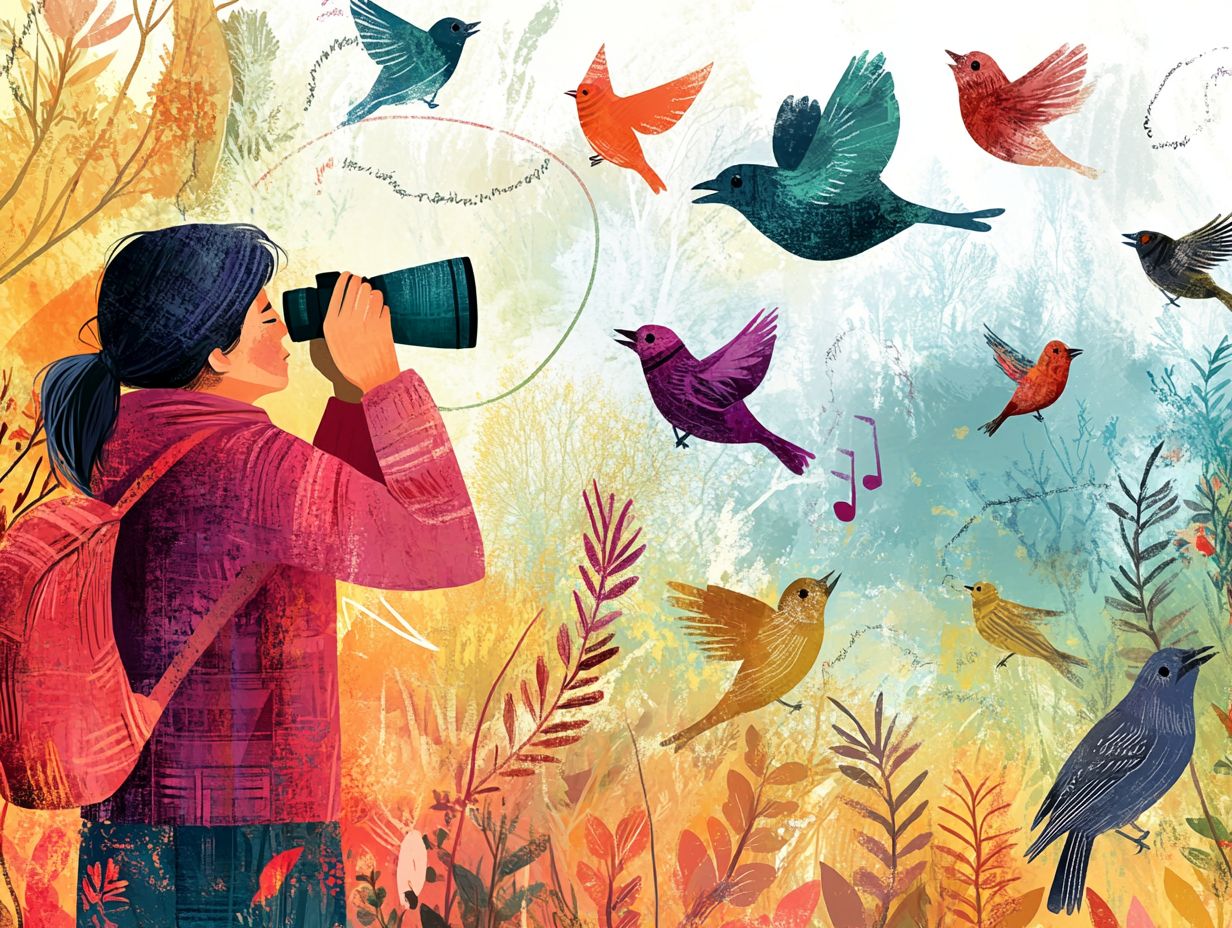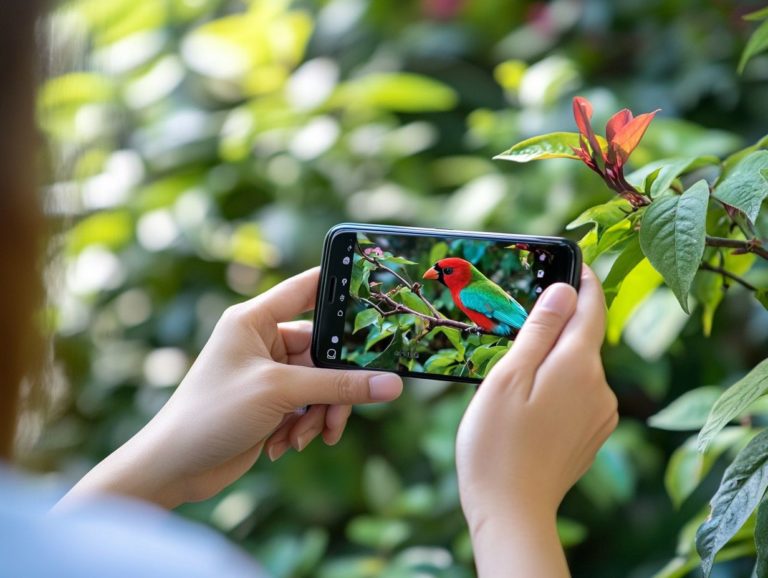How do Bird Calls Help in Bird Watching?
Bird calls are the heartbeat of your birdwatching adventure! They serve as vital instruments for bird watchers, including avid enthusiasts like Kelley Luikey and Kenn Kaufman, enabling you to forge a deeper connection with our avian companions.
Understanding the importance of these calls can enrich your observations and heighten your appreciation for the vibrant world of birds.
This guide offers techniques and tools for identifying common calls and mastering the art of locating birds through their sounds, such as those of the Carolina wren and American Robin. Your bird-watching experience will be truly rewarding.
Additionally, bird calls play a crucial role in conservation efforts. Understanding bird acoustics and employing tools like the Merlin app can assist in safeguarding these enchanting creatures.
Immerse yourself in this exploration and discover how the captivating symphony of bird calls can elevate your bird-watching journey, especially in diverse locations like Florida’s Audubon magazine-featured sites, including the Everglades National Park.
Contents
- Key Takeaways:
- The Role of Bird Calls in Bird Watching
- Identifying Bird Calls
- Using Bird Calls for Location and Observation
- Bird Calls and Conservation
- Frequently Asked Questions
- What are bird calls and how do they help in bird watching?
- Why is it important for bird watchers to learn and understand bird calls?
- How can bird calls be used to attract birds during bird watching?
- Do all bird species have distinct calls, and how can one learn to recognize them?
- Can bird calls be used to communicate with birds during bird watching?
- How can bird calls help in conservation efforts for bird species?
Key Takeaways:

- Bird calls are vital for spotting and identifying our feathered friends!
- Various types of bird calls can be easily identified with the right tools and techniques.
- Bird calls provide valuable insights into behaviors and interactions among birds.
- Bird calls are crucial in monitoring and protecting bird populations for conservation.
The Role of Bird Calls in Bird Watching
Bird calls are essential to your birdwatching experience, acting as crucial tools for enthusiasts like Kelley Luikey and Kenn Kaufman who strive to identify and appreciate diverse songbirds, such as the Yellow-headed Blackbird, in their natural habitats.
Understanding these vocalizations elevates your birdwatching and deepens your knowledge of species like the Carolina wren and American Robin. These birds use their calls for defending territory, attracting mates, and communicating during the breeding season, showcasing their complex vocalizations.
Harnessing cutting-edge technology like the Merlin app enhances your ability to accurately identify and catalog bird calls and behaviors, making your birdwatching adventures even more rewarding.
Why Bird Calls are Important
Bird calls hold immense significance as they serve essential functions, including territory defense, mate attraction, and communication during the breeding season among various songbirds, including the Northern Cardinal.
These vocalizations are critical for survival, helping to establish and maintain social hierarchies. For example, the melodious call of the Yellow-headed Blackbird attracts potential mates and signals to rivals that a territory is occupied, effectively minimizing conflict.
Similarly, the subtle yet distinct trill of the Henslow s Sparrow is vital for mate recognition, allowing individuals to identify and connect with their species, just as the Carolina wren does during breeding. These calls are more than mere sounds; they are vital components of an intricate ecological web that enhances reproductive success and fosters cohesion among avian populations, contributing to the overall health of their habitats.
Identifying Bird Calls
Identifying bird calls is an essential skill for you as a bird watcher, conservationist, or even an underwater acoustician studying their impacts. This skill enables you to recognize and appreciate the rich tapestry of vocalizations from various species, such as the American Robin, the Carolina Wren, and the elusive Connecticut Warbler.
This skill is often enhanced through the use of example sound files and bird playback resources, allowing you to immerse yourself in the delightful symphony of nature while learning about their behaviors.
Common Types of Bird Calls

Common types of bird calls encompass a fascinating array of vocalizations from popular species like the American Robin, Henslow s Sparrow, the Northern Cardinal, and more. Each species has its own distinctive sounds that serve various purposes.
These calls can be broadly categorized into songs, alarm calls, and contact calls. Each plays a critical role in bird communication and interactions among social structures. For example, the enchanting song of the American Robin often graces the dawn chorus. It signals territory and attracts mates, much like the calls of the Great Kiskadee.
The Henslow s Sparrow uses soft, chip-like calls to maintain contact with its mate while foraging through dense grasslands. This showcases the nuances of bird sounds. Alarm calls, such as the sharp notes emitted by a Northern Cardinal or the Black-capped Chickadee, alert others to potential dangers nearby.
By immersing yourself in audio examples of these unique vocalizations through platforms like Xeno-canto, you’ll discover a whole new world of bird sounds that will amaze you!
Tools and Techniques for Identification
Effective tools and techniques for identifying birds have evolved significantly. You now have access to resources like the Merlin app, bird playback technologies, and the American Birding Association’s recommendations. These provide innovative ways to recognize various species based on their calls and sounds.
These resources transform the once-daunting task of bird identification into an engaging experience. Whether you re a hobbyist, seasoned birdwatcher, or just someone eager to learn more about bird habitats, there s something for everyone. With bird call identification apps like ChirpOMatic and BirdNET, you can easily record and identify bird sounds using your smartphone, creating a personalized library of localized calls.
Websites like Xeno-canto and other conservation-focused platforms offer an extensive database of bird audio recordings. These allow you to compare unfamiliar calls while out in the field.
Use these tools effectively by practicing your listening skills, studying regional bird calls, and respecting the ethics of birding. Not only will this help you recognize calls, but it will also deepen your understanding of the context in which they occur, enriching your overall birding adventure.
Using Bird Calls for Location and Observation
Employing bird calls for location and observation can greatly elevate your bird-watching experience. This approach not only enables you to locate specific species with ease but also deepens your understanding of their behaviors, including how they interact with their habitat, defend their territory, and attract mates during the breeding season. To enhance your skills, consider understanding bird calls with the right field guide.
How to Find Birds Using Calls
Finding birds by their calls requires you to hone your listening skills and familiarize yourself with the unique vocalizations of local songbirds like the Eastern Towhee and the Black-capped Chickadee. This familiarity allows you to locate them with greater ease.
By tuning into the distinct sounds made by various species, you can uncover fascinating insights into their behaviors, social hierarchies, and habitats. For instance, the sweet, melodic whistling of an American Robin often fills the air at dawn. Those early mornings are the perfect time to observe these vibrant creatures in action, alongside the calls of the Great Kiskadee.
The sharp chewink of the Eastern Towhee or the soft notes of the Yellow-headed Blackbird signal its presence in shrubby areas, serving as a delightful auditory clue.
Recognizing that certain birds are more active during specific seasons or times of day can considerably enhance your birdwatching experience. Pay attention to the patterns and pitches in their calls. This not only improves your identification skills but also deepens your connection with the natural world and helps you understand the importance of bird habitats.
Observing Behavior and Interactions

Observing the behavior and interactions of birds, such as the Carolina wren, in their natural habitats provides you with invaluable insights into their social structures. This includes everything from mate attraction to territory defense strategies while upholding the ethics of birding.
Practicing ethical birding not only safeguards these remarkable creatures but also enriches your own experience as an observer. You can witness intricate behaviors of songbirds in their habitats. Imagine seeing how specific species, like the American Robin and the Henslow’s Sparrow, use calls to communicate during courtship rituals. Watching them engage in competitive displays is utterly fascinating.
Take the American Robin as an example. Its melodic song serves the dual purpose of establishing territory and enticing a mate, much like the vocalizations of the Northern Cardinal. Similarly, the lively interactions among crows and their distinctive calls reveal intricate details about their social hierarchies and cooperative behaviors.
Crows use their calls to work together. They often rely on these vocalizations to coordinate group activities, communicate potential threats, and maintain their social structure.
By respecting their space and minimizing disturbances, you actively contribute to a deeper understanding of these captivating social dynamics. This ensures future generations can also enjoy the extraordinary world of birds, including those in National Wildlife Refuges.
Bird Calls and Conservation
Bird calls are important for protecting birds. They offer researchers and conservationists invaluable data to monitor and safeguard bird populations and their habitats, like those within Theodore Roosevelt National Park.
By understanding these vocalizations, you can enhance your contributions to protecting the natural world.
Impacts on Bird Populations
Understanding the effects of bird calls on bird populations is crucial for creating effective conservation strategies. This is especially important given environmental pressures like habitat destruction and climate change. Bird calls often indicate population health and can reveal shifts in behavior and habitat use due to external factors affecting the ecosystem.
For example, researchers have noted a decline in certain songbird species, such as the Eastern Meadowlark. This decline correlates with a drop in their calling frequency, suggesting significant environmental pressures like habitat destruction and climate change.
The Eastern Meadowlark, whose dwindling grassland habitats have resulted in fewer calls, signals stress and lower reproductive success. This emphasizes the need for conservation efforts in areas like Botany Bay.
Consequently, conservation efforts are increasingly focusing on habitat restoration. This approach creates better homes for birds, giving them a fighting chance while also reviving these vital vocalizations and reflecting a more stable population dynamic.
Using Calls to Monitor and Protect Birds
You can monitor and protect birds by using different methods to listen to their calls. This enables you to gather critical data on species presence, distribution, and habitat needs, ultimately bolstering conservation efforts.
These methods range from traditional recording devices to advanced machine learning algorithms that analyze sound patterns. One remarkable technology at your disposal is autonomous recording units. You can strategically place these in bird habitats to capture calls over extended periods.
This continuous monitoring offers invaluable insights into breeding behaviors and migratory patterns.
You can also use smartphone apps to contribute data through straightforward recordings of local bird calls. These collaborative efforts foster community engagement and help create a more comprehensive database, enabling targeted conservation strategies tailored to specific species and their unique habitats.
Frequently Asked Questions

What are bird calls and how do they help in bird watching?
Bird calls are sounds that birds make to communicate. They provide important clues about where birds are, what they are doing, and what kinds of birds are nearby.
Why is it important for bird watchers to learn and understand bird calls?
Knowing bird calls helps bird watchers identify birds while watching different species. This skill enhances their birding adventures and aids valuable research efforts.
How can bird calls be used to attract birds during bird watching?
Bird watchers can play recorded calls or mimic them to draw birds closer. This tactic allows for better observation and photography opportunities.
Do all bird species have distinct calls, and how can one learn to recognize them?
Yes, every bird species has its own unique call. Bird watchers can improve their skills using guides, mobile apps, or by joining birding groups.
Can bird calls be used to communicate with birds during bird watching?
Some birds may respond to calls, but using them can disrupt natural behavior. Many bird enthusiasts consider this approach unethical.
How can bird calls help in conservation efforts for bird species?
Bird calls provide key data on species presence and distribution. By recording and sharing calls, bird watchers assist in tracking population changes and spotting threats.






